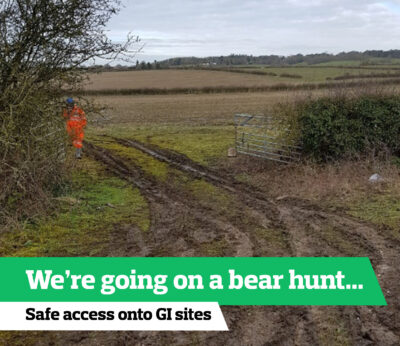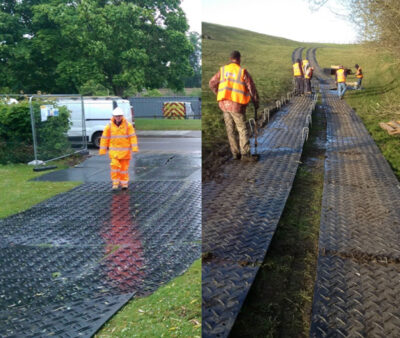
Reproduced by kind permission of AGS, the magazine of the Association of Geotechnical and Geoenvironmental Specialists.
We’re all going on a bear hunt…
Well, maybe not a bear hunt, but if you have small children you will be able to relate to mud…you can’t go under it, you can’t go over it, so let’s go through it….squelch, squelch, squelch.
Following the record breaking winter of 2019-2020, where wet weather continually interrupted and caused havoc on sites throughout the UK, The AGS Safety Working Group has been looking at safe access to construction sites, particularly with reference to ground investigation.
The nature of our work often involves accessing sites with heavy vehicles and machinery. This may cause many health and safety issues, landscape destruction and habitat loss, and very unhappy landowners who were unprepared for the disruption we may have caused.
Consideration of ground disturbance during the contract is often neglected within the framework of the Construction, Design and Management Regulations (CDM 2015) and is often a major factor in contractual disputes. Additionally there is often a significant time lapse and delay between the pricing of a project and site mobilisation, with deteriorating weather conditions having a significant impact on the ground conditions.
In this article we explore how we can work together to avoid these situations. A walkover of the site by both the designer at design stage and the Contractor at tender stage is a good first start. This will determine likely site access conditions and allow consideration of the likely options to consider for gaining safe access to the site.
The Role of CDM
When considering, the obligations of Clients, designers and contractors in relation to CDM 2015 need to be satisfied. The Client must make sure there is sufficient time and resources allocated, the Designer must manage, monitor and coordinate health and safety in the construction phase of a project and the contractor must prepare the construction phase plan (CPP), including the risk assessment and method statements. Contractors must ensure that the vehicles engaged on the site are suitable for the task, e.g. with all-terrain tyres or tracks. All drivers must be competent to drive all-terrain vehicles through appropriate training and experience. Recovery of bogged down vehicles must also be considered and documented, with a safe method of recovery using appropriate equipment, training and resources.

The Options
There are broadly three types of methods to gain access to site:
No ground protection: Direct access by vehicles and machinery with the intention to reinstate on contract completion. This method has several disadvantages including delays caused by bogged down vehicles; unsafe ground conditions including rutting and slip, trips and falls hazards; harm to protected species particularly on fragile grasslands; habitat destruction; damage to the ground; and mud taken out onto the highway. An issue with this method is the unknown amount of reinstatement that will be required on completion, whether the supervisor and landowner will be satisfied, and who covers the costs.
Roadway Construction: Construction of a temporary roadway using imported granular materials is classified as temporary works with associated implications. Importation of road construction materials requires good source and site control to prevent potentially contaminated materials entering site, particularly when demolition rubble is used which may contain metal, asbestos fragments, tarmacadam and organic materials. A geotextile type membrane is often placed between the imported materials and the original ground surface. Further issues may include construction time of the road before ground investigation can commence; poor drainage and soft ground beneath the roadway; costs associated with the temporary works; and removal and controlled disposal after the works are complete.
Ground Protection: Roadways and paths can be protected from extensive damage from vehicles and footfall using ground protection in the form of temporary trackway mats. Trackway has the advantage of being generally portable, reduce reinstatement work and costs, can be site specific, and reduces the likelihood of vehicles becoming stuck.
How CDM and our Options work together
Preparation of the CPP for either of the chosen access methods listed above will require a consideration of hazards and regulations. Hazards to consider are:
No ground protection
- Unsafe ground conditions due to mud/soft ground causing vehicle accidents
- Slips, trips, falls due to soft ground and vehicle rutting
- Mud on local roads
- Landscape and habitat destruction
Roadway construction
- Increased vehicle traffic to/from site delivering/removing materials
- Potentially contaminated materials including asbestos and sharps
- Underlying soft spots causing uneven tracks with potential for vehicle accidents
Tracking matting
- Manual handling, particularly if covered in mud
- Slips trips falls if become wet and muddy
- Mats slipping if not properly connected, plus ground anchored if on a slope
- Specifying the correct mats for the job is important to minimise damage to them or the ground
- Lifting of mats using equipment
- Ecology- it is known that small vertebrates and amphibians can crawl under the mats overnight and may be crushed if mat travelled over by a vehicle
The pre-construction Health and Safety assessment must identify these hazards specific to the site. With knowledge of these hazards the Client must allow sufficient time and resources to the project to allow safe access. This means enough time for safe access to be resourced for. It is the Designers duty to eliminate, reduce, isolate or control foreseeable risks that may arise perhaps by considering if the work at that location is actually required, considering and arranging different access points, changing the type of work therefore reducing equipment and vehicle movements or how to control the hazards by the type of ground protection required. It is the Contractors duty to ensure that the activities are carried out to the design, safely. This includes the installation as per the manufacturer’s instructions.
The Designer and Contractor also have responsibility to recognise the possible damage to the ground surface when carrying out construction-based activities. Whatever the activity, ground disturbance almost always happens to some degree and can be very weather dependant. Leaving the ground in a safe condition at the end of works is a primary requirement but leaving it so that it looks as if no work has been done is practically impossible.
The Specification
The UK Specification for Ground Investigation addresses ground disturbance in Clauses 3.15, 3.16 and 3.17. Particular reference should be made to Clause 3.15.1:”all work shall be carried out with the least possible damage to the site and its environs” and Clause 3.16.1: “the whole of the site and any ancillary works shall be left in a clean and tidy condition”.
The site-specific specification then often lists a lot of subjective statements that are difficult to accurately cover at tender stage such as:
It is required that wherever the ground surface (hard or soft finish) is disturbed by the investigation activities, the contractor will reinstate the surface fully using the same materials to match as closely as possible to the original finish to the satisfaction of the property owner.
The Contractor shall make good damage, whether in the vicinity of the hole or on the access route there to the satisfaction of the Investigation Supervisor.
To avoid prolonged contractual argument regarding the reinstatement the designer should ensure that all CDM responsibilities are upheld, the Client is fully briefed into what to expect during and after the works, and that there is sufficient site specific detail to allow the contractor to adequately and fairly cover reinstatement costs in the contract.
CLICK HERE to find out more about ground protection methods.
Authors
Elizabeth Withington, Principal Engineering Geologist CC Ground Investigation Ltd
Marcus Oliver, Product Development Manager Ground Guards UK
References
- The Construction (Design and Management) Regulations 2015
- The Manual Handling Operations Regulations 1992
- The Provision and Use of Work Equipment Regulations 1998
- The Lifting Operations and Lifting Equipment Regulations 1998
- Wildlife and Countryside Act 1981
- UK Specification for Ground Investigation Second Edition 2012